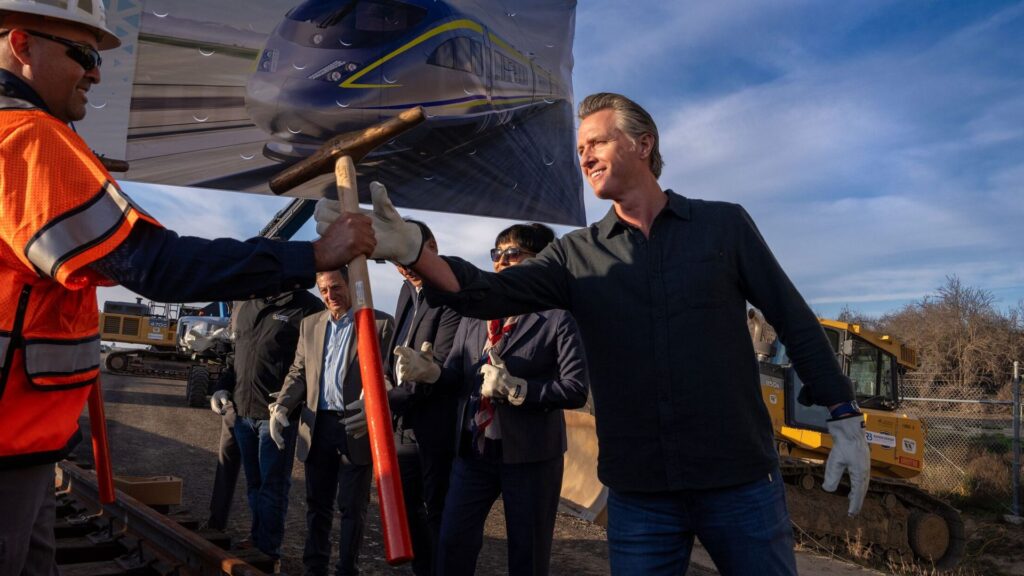In January, California Gov. Gavin Newsom, D, joined rail authority officials outside of Bakersfield to celebrate the initial construction of the state’s high-speed rail. The governor hammered a ceremonial spike into the ground and discussed the project.
“No state in America is closer to launching high-speed rail than California — and today, we just took a massive step forward,” Newsom said.
In a moment of symbolism, the spike wasn’t for the actual high-speed rail. Instead, it commemorated a railhead for a traditional track that will deliver supplies to the high-speed rail construction work that’s to begin at a later date.
California’s high-speed rail line, a decades-old public works project that has yet to see a train in operation or any cities connected by the rail despite billions of dollars spent and targets missed, is in need of more funding. Newsom’s budget revision is proposing a new multi-billion-dollar revenue stream using funding meant to reduce pollution.
The proposal is meant to shore up a widening gap between what’s needed to keep the expansive project on track and what the state’s volatile budget can afford after President Donald Trump made it clear that there’d be no help from Washington.
Unbiased. Straight Facts.TM
The original cost estimate for the San Francisco to Los Angeles high-speed rail project was $33 billion with a finish date in 2020, but new estimates peg the ongoing project at over $106 billion.

Deeper hole
NBC affiliate KCRA obtained documents saying the Bakersfield to Merced line could need more funding than most recently estimated. The memo reportedly warned that the line’s cost could increase by up to another $3.2 billion. If accurate, the total project’s budget deficit would amount to more than $10 billion. The memo reportedly pointed to inflation and the increasing cost of materials.
In the years since initial approval, the “starter line” connecting the two inland cities has grown to $38.5 billion. The 2008 bond, expected to pay for much of the project, was for $33 billion.
Cap and trade funds
Newsom’s May revision to the state’s budget proposes using funding from the state’s cap-and-trade auction for the high-speed rail project. He said the dedicated funding stream of at least $1 billion annually would “establish a stable and predictable funding stream” that would allow railway officials to plan better. His proposal would also see the extension of the cap-and-trade program that’s funded by purchases of allotments to offset pollution to 2045. The auction is set to wind down in 2030.
“A guaranteed minimum funding level will also improve the project’s ability to attract private capital and leverage additional funds upfront, which will accelerate project delivery, lower long-term costs, and increase flexibility through alternative delivery methods,” his proposal states.
Trump not interested
Funding for the railway depends on continual influxes of cash from the state and the federal government. U.S. Department of Transportation officials have cast doubt on the thought of replenishing the project’s coffers, and Trump poured cold water on the project earlier in May.
“That train is the worst cost overrun I’ve ever seen,” Trump said in a May 6 media availability in the Oval Office. “We’re not going to pay for that thing.”
Will it ever finish?
The ambitious project was pitched in 2008 with a target completion in 2020. Delays from environmental impact studies mandated by state and local law ate up more than a decade. According to the Free Beacon, the cost of those studies was $537 million.
The Bakersfield to Merced line is the first to see construction take place. A Feb. 3, 2025, report from the California Office of the Inspector General said the already-delayed completion date of 2033 is unlikely. The report points to previous delays, future uncertainty and ongoing disagreements with third parties.
Rail authority officials are scheduled to give an update this summer.
contributed to this report.


